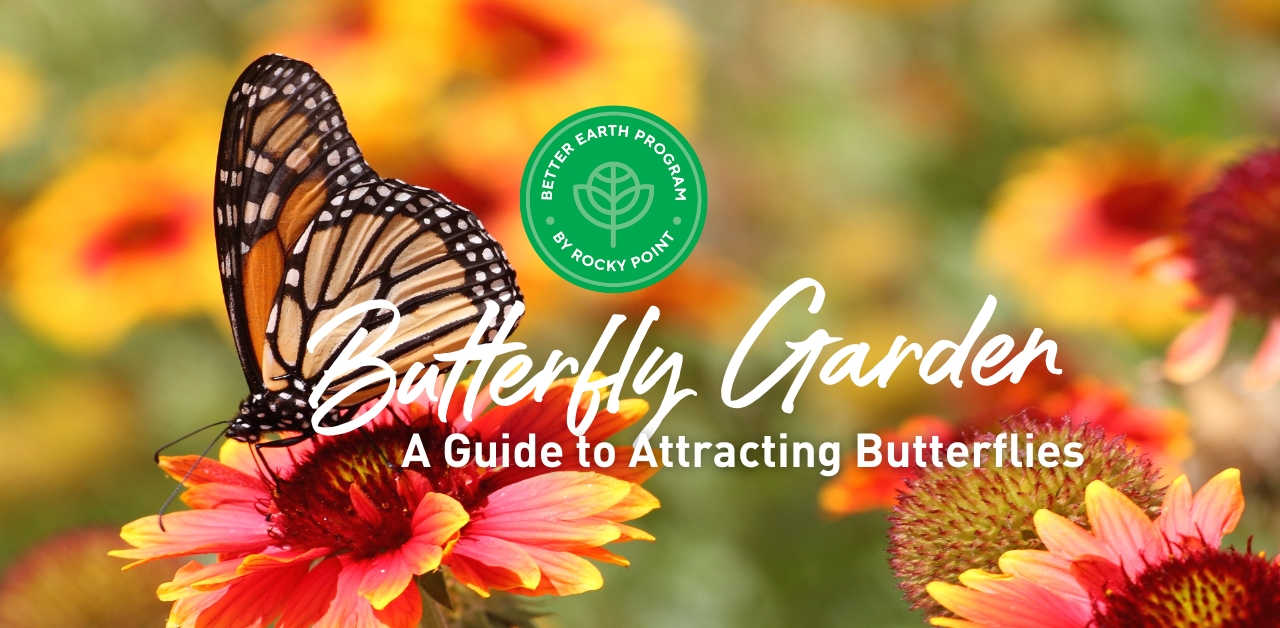Butterflies are more than just a pretty face in the garden. They also play an important role in pollination. Butterflies may not be as critical as bees but because of their capacity to travel much larger distances and their differing physiology they are still very effective pollinators for a variety of different plants far and wide.
So how do you attract more butterflies to your garden?
Plants are the obvious starting point but it’s not just all about flowering plants and their provision to provide a nectar food source via their blooms. Butterflies also need what we call host plants.
These are the preferred plants on which butterflies lay their eggs and the caterpillars feed on when they hatch. Each species of butterfly has various set host plants that they will only lay their eggs on. To encourage various species into your garden it’s a great idea to see which host plant attracts which butterfly for your area and go from there.
When it comes to planting plants for a nectar source for the adult butterflies, they will happily feed off a myriad of native and exotic species of flowers. Choose a wide and varied selection of flowering plants and aim to have something in flower every month of the year.
With plantings of host flowering plants, your garden may very well be one of the few what I call urban stepping-stones within your neighbourhood.
Protect butterflies by not using chemicals in your backyard and remembering that most caterpillars you come across in your garden are more than likely baby butterflies.
The Top 10 Butterfly-Friendly Plants for Your Garden:
- Lantana (Lantana camara): Lantana is a hardy shrub that produces clusters of colourful flowers. It's loved by a wide range of butterfly species.
- Swan Plant (Gomphocarpus fruticosus): Also known as the Milkweed, this plant is essential for Monarch butterflies as it serves as a host plant for their caterpillars.
- Buddleja (Buddleja davidii): Often called the Butterfly Bush, this plant is well-known for attracting butterflies with its fragrant blooms.
- Salvia (Salvia species): Salvias are known for their tall spiky flower heads and are highly attractive to butterflies.
- Zinnia (Zinnia elegans): Zinnias are annual flowers that come in a wide range of bright colors. They are great for attracting butterflies.
- Verbena (Verbena species): Verbena is a low-growing perennial that produces clusters of small, colorful flowers that butterflies adore.
- Alyssum (Lobularia maritima): This low-growing ground cover plant produces clusters of tiny, sweet-smelling flowers that butterflies find irresistible.
- Butterfly Bush (Rotheca myricoides): Another plant referred to as Butterfly Bush, this one is native to Australia and is a popular choice for attracting butterflies.
- Pentas (Pentas lanceolata): Also known as Egyptian Starcluster, Pentas produce star-shaped flowers that are rich in nectar, making them a favourite of butterflies.
- Milkwood Vine (Parsonsia species): This climbing plant is native to Australia and is an excellent host for butterflies. It provides a habitat for caterpillars and nectar for adult butterflies.
Remember to consider the specific climate and soil conditions in your area when selecting plants. Additionally, providing a water source like a shallow dish with wet sand or rocks can also be helpful for butterflies. Happy gardening!
From Caterpillar to Butterfly: Understanding the Life Cycle and Behaviour of Butterflies in Your Garden
Understanding the life cycle and behaviour of butterflies is not only fascinating but also important for creating a hospitable environment in your garden. Here's a breakdown of the stages and behaviours:
1. Egg Stage:
- Butterflies begin their life cycle as eggs, usually laid on the leaves of host plants.
- Each species has specific host plants where they lay their eggs, as these plants will later serve as food for the caterpillars.
2. Caterpillar (Larva) Stage:
- Once the egg hatches, a caterpillar emerges. This stage is focused on eating and growing.
- Caterpillars have specialized mouthparts for chewing plant material.
- They undergo a series of molts, shedding their exoskeletons to accommodate their growing bodies.
3. Pupa (Chrysalis) Stage:
- After reaching a certain size, the caterpillar attaches itself to a secure surface and transforms into a chrysalis.
- Inside the chrysalis, the caterpillar undergoes a remarkable metamorphosis, rearranging its body into the form of a butterfly.
4. Adult (Imago) Stage:
- Once the transformation is complete, the adult butterfly emerges from the chrysalis.
- The butterfly will pump fluid into its wings to expand them and dry them out, preparing for flight.
- The primary goal of adult butterflies is reproduction.
Butterfly Behaviour in Your Garden:
1. Feeding:
- Adult butterflies feed on nectar from flowers. They are attracted to bright, fragrant flowers, and they can see a wide range of colors.
- Consider planting a variety of nectar-rich flowers to attract and sustain them.
2. Mating:
- Butterflies have specific behaviors and signals for mating. Some species engage in elaborate courtship dances.
- Provide open spaces in your garden where butterflies can fly freely, facilitating mating opportunities.
3. Host Plants:
- As mentioned earlier, specific butterfly species lay their eggs on particular host plants. Including these plants in your garden can support their life cycle.
4. Sunbathing:
- Butterflies are ectothermic, which means they need external sources of heat. They often spread their wings to soak up sunlight for energy.
5. Puddling:
- Male butterflies gather in groups to sip moisture from damp soil or mud. This behavior, known as puddling, provides essential minerals and salts.
6. Migration:
- Some butterfly species engage in long-distance migrations. Providing a continuous supply of nectar-rich flowers can be crucial for their journey.
Remember, providing a pesticide-free environment is essential for the health and well-being of butterflies at all stages of their life cycle. With thoughtful planting and maintenance, you can create a butterfly-friendly haven in your garden.
For more valuable information head to the Butterfly and Other Invertebrates Club www.boicorg.au.
Get more great gardening tips join our Better Earth Programme and receive a free seasonal Gardening Magazine
_MEB.png?width=842&height=596&name=RP_HorizontalColour(R)_MEB.png)



